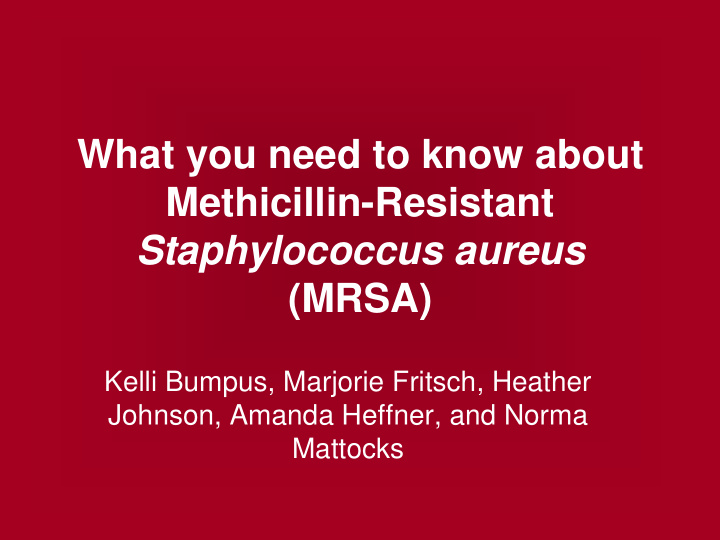



What you need to know about Methicillin-Resistant Staphylococcus aureus (MRSA) Kelli Bumpus, Marjorie Fritsch, Heather Johnson, Amanda Heffner, and Norma Mattocks
So, What is Staphylococcus aureus ??? • “Staph” are bacteria that are commonly carried on the skin or in the nose of healthy people • One of the most common causes of skin infections in the U.S. – Most are minor (pimples or boils) and wont need treatment with an antibiotic • The bacteria can cause serious infections such as surgical wound infections, bloodstream infections and www.cdc.gov, 2007 pneumonia
Ok then…What is MRSA??? • Staph bacteria that become resistant to antibiotics over time • MRSA is staph bacteria that is resistant to beta-lactam antibiotics – These antibiotics include methicillin, as well as penicillin, oxacillin and amoxicillin. • 20% - 30% of the population is colonized with regular staph and approximately 1% are colonized with MRSA
So tell me this, how does bacteria become resistant??? • Three ways bacteria becomes resistant: – Over-use of antibiotics – Overall change in bacteria DNA – Over-use of antibiotics in cattle
Your asking yourself, How can I catch MRSA??? • Most common transmission is skin to skin contact • Touching contaminated surfaces • Living in crowded facilities • Having poor hygiene
What is the difference between hospital acquired and community acquired MRSA??? • Community-Acquired • Hospital-Acquired – No recent history of – History of recent hospitalizations, surgery, hospitalizations, surgery, dialysis, etc. dialysis, or live in long term – Most manifest themselves as care facilities skin infections, pimples or – Immunocompromised boils, and occur in otherwise patients healthy people. – Data from a prospective – Usually responsible for study in 2003, suggests that hospital acquired 12% of clinical MRSA pneumonia, bloodstream infections are community- infections and surgical associated, but this varies by wound infections geographic region and – Resistant to many other population. antibiotics
Who is at risk of acquiring MRSA??? • The Center for Disease Control has reported high risk members for acquiring CA-MRSA: – Athletes – Military Recruits – Children – Pacific Islanders – Alaskan Natives – Native Americans – Gay Men – Prisoners • Those with recent hospital stays are at risk for acquiring HA-MRSA
If I have it, What does it look like??? • MRSA looks like any other Staph skin infection. – It looks like a pimple or boil which can be red, swollen, painful and have pus or other drainage • Only a health care professional can confirm MRSA through lab testing
Most importantly…How can I prevent catching MRSA??? • Prevent catching MRSA by performing good hygiene – WASH YOUR HANDS CORRECTLY or use a alcohol- based hand sanitizer – Keep cuts or scrapes clean and covered – Avoid contact of anyone else’s wounds – Avoid sharing personal items (towels, razors, etc.) – Disinfect desks, gym equipment, and gym mats regularly
Proper Hand Washing is #1 • Wet your hands with clean running water and apply soap, use warm water if it is available • Rub hands together to make a lather and scrub ALL SURFACES • Continue rubbing hands for 20 seconds, try “Happy Birthday” twice • Rinse hands well under running water • Dry your hands using a paper towel or air dryer. If possible, use your paper towel to turn off the faucet • If soap and water is not available use alcohol based hand sanitizer
How will my physician treat my infection??? • Don’t worry…MRSA is treatable • Proper wound care • Antibiotics (take full dose) – Common medications used are vancomycin and teicoplanin • Both need to be administerd IV or IM so they are given in a hospital setting • Report back to physician if it does not resolve • YOU CAN GET MRSA AGAIN!
How do I prevent spreading MRSA to others??? • Cover your wound: keep open wounds covered with a dry, clean bandage • Wash your hands constantly and remind others around you to wash frequently • Avoid sharing any personal items, these include: towels, razors, clothing, washcloths, or uniforms – Wash any sheets, towels or clothes that become soiled
Just so you don’t forget, here is a Summary • MRSA is a antibiotic resistant Staph • More common in hospitals and long-term care facilities • Community acquired MRSA is more easily treated • Hand washing is your best protection against catching MRSA • School desks and gym equipment are common sites to catch MRSA • See your doctor if you suspect you might be infected
What references did we use??? • Centers for Disease Control and Prevention. (2007). Have you been diagnosed with a Staphylococcus aureus or MRSA infection? Retrieved October 23, 2007. http://www.cdc.gov/ncidod/dhqp/ar_mrsa.html. • Pennsylvania Department of Health. (2007, October). Communicable Disease Fact Sheet: MRSA. Retrieved October 23, 2007. http://www.dsf.health.state.pa.us/health/cwp/view.asp ?A=171&Q=248923&pp=12&n=1. • Pennsylvania Department of Health. (2005, July). MRSA: Get the Facts. Retrieved October 23, 2007. http://www.dsf.health.state.pa.us/health/cwp/view/asp ?a=178&q=248839 • Pennsylvania Department of Health. (2005, July). Recommendations on Children with Methicillin-Resistant Staphylococcus aureus (MRSA) in School Settings. Retrieved October 23, 2007. http://www.dsf.health.state.pa.us/health/lib/health/phi /Clinical_Management_MRSA.pdf
QUESTIONS???
Recommend
More recommend